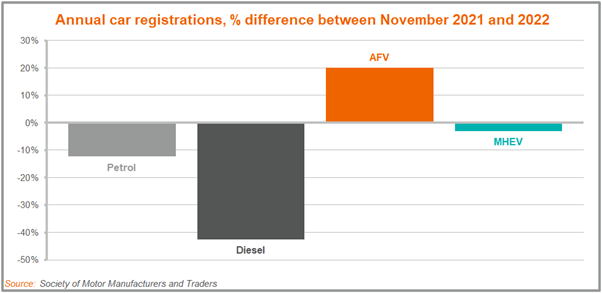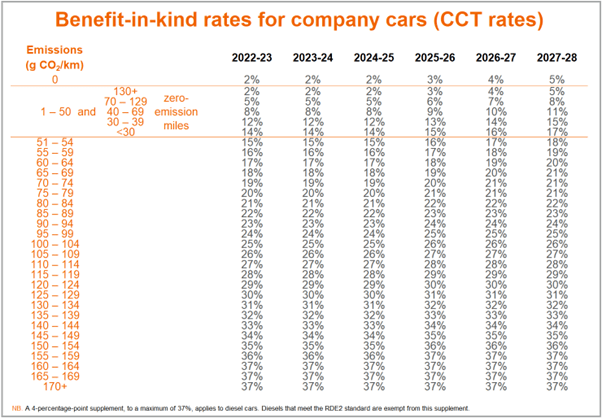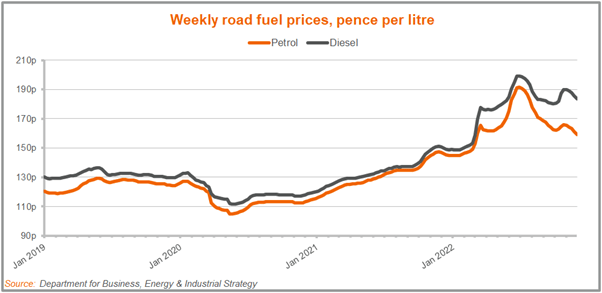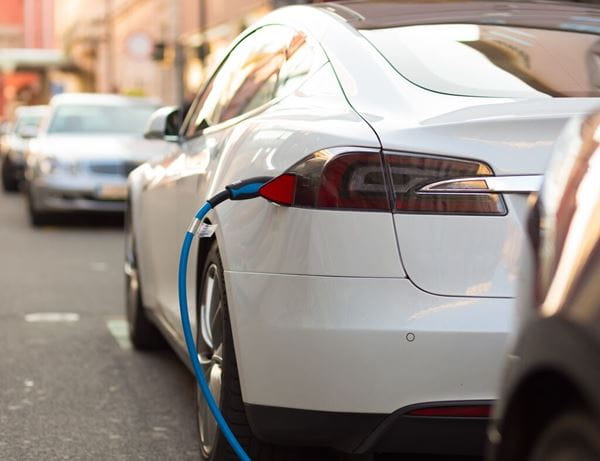
2022: The Year In Review
2022 has been a significant year for fleets and motorists - we thought we’d look back on it all by picking five key highlights. Read our review of the year.
2022 has been a momentous year. Globally, the effects of the pandemic are still being felt, even as more people are getting vaccinated, and Russia’s invasion of Ukraine only added to the pressure on supply chains. At home, in the UK, we have witnessed the sad passing of one monarch and the ascension of another, as well as the spectacle of three Prime Ministers, four Chancellors, and more policy u-turns than we could count.
It has been a significant year for fleets and motorists, too. We thought we’d look back on it all by picking five key highlights.

Overall, car registrations have been relatively flat throughout 2022. Thanks in part to economic uncertainty, the numbers are still around their depressed 2020 levels and significantly lower than the record highs of several years ago.
However, there’s one area that is showing astonishing growth: electric vehicles (EVs). Whereas both petrol and diesel sales have declined during 2022, registrations of alternatively fuelled vehicles (AFVs) – which are, in the Society of Motor Manufacturers and Traders (SMMT)’s statistics, various forms of EV – stood at almost 540,000 in the 12 months to November this year, which is 20% higher than a year previously.
This has shaken up the marketplace. Across the past 12 months, 33.7% of cars registered were AFVs, which is far ahead of diesel (5.3%) and within striking distance of petrol (42.8%). Could 2023 be the year when electric finally tops the charts?
The answer to that question could well depend on supply. While the demand for EVs is clearly strong, their availability has still been hampered in 2022 by the semiconductor shortages that were triggered by the pandemic and then exacerbated by the war in Ukraine. In fact, the sales figures would likely have been even stronger had these extrinsic factors not played a role.
And there are other issues, too. Earlier this year, for World EV Day, LeasePlan UK and a number of other partners commissioned a landmark survey of motorists to determine the state of public opinion around EVs. The results were generally encouraging: for example, 64% of those who are intending to buy a car would consider an EV. But a number of concerns were also raised: for example, 46% of respondents believed that EVs have higher whole life costs than their fossil-fuelled counterparts. There was also some confusion around charging and around just choosing an EV in the first place.
The good news is that these concerns and confusions are solvable ones – not least because they’re mostly based on misperceptions. In our research report, we even game a number of possible solutions, which fall into three categories:
- 1.Make EVs more affordable, such as by showing drivers where EVs save money – and they really do – in comparison to petrol and diesel vehicles.
- 2.Make them simple, such as by providing clearer numbers for driving range.
- 3.And make them intuitive, such as by making charge points more visible.
Affordable. Simple. Intuitive. These are good New Year’s Resolutions for anyone who wants to advance the cause of cleaner motoring.

Another new government – and new tax hikes
We’ve had three Prime Ministers in 2022 – Boris Johnson, Liz Truss and Rishi Sunak – all of them Conservative, but each with different legislative ideas and priorities. It is, of course, Sunak who is in charge now, so it’s his legislation that counts, and we saw quite a lot of it in the Autumn Statement that his Chancellor, Jeremy Hunt, delivered in November.
This Statement was a significant one for fleets for several reasons (including for what it didn’t say about Fuel Duty – see below), but mostly for how it treated EVs. From 2025, EVs will no longer be exempt from Vehicle Excise Duty (VED) – they will have to pay a first-year rate of £10, followed by a standard annual rate of £165. They will also be subject to the additional rate for vehicles worth over £40,000.
And EVs also face higher rates of Company Car Tax (CCT) from 2025-26 on – rising to 5% for zero-emission vehicles in 2027-28. The full range of rates of shown in the table above.
It had been speculated ahead of the Autumn Statement that future CCT rates for EVs could be significantly higher – perhaps even rising to 10% for zero emission vehicles – so we are glad that that didn’t materialise. But the actual, published rates do still suggest that the Government is no longer prepared to give EVs a free – or close to free – ride. With more and more fleets and motorists going electric, the Treasury and HMRC are trying to secure tax revenues where they can.
However, one thing we didn’t see in the Statement, nor in 2022 in general, was the Government taking the first steps towards a full realignment of the vehicle taxation system: away from taxing petrol, diesel and carbon emissions – and perhaps towards taxing motorists’ mileage, in the form of Road Pricing. This will be something to look out for in 2023.

The cost of living – and of fuel
Geopolitical shocks have rippled into our lives in 2022. Due in large part to the pandemic, and then to the effects of the war in Ukraine, the cost of living has risen dramatically. According to the Office for National Statistics, the main measure of inflation, the Consumer Price Index (CPI) rose by 11.1% in the 12 months to October 2022. The Bank of England excepts it to remain above 10% for at least the first quarter of 2023. These are the highest totals for at least 40 years.
For most motorists, these effects will have been most noticeable at the petrol pumps – where prices reached record highs. From the start of the year to the first week of July, the price of a litre of petrol rose by 32% to 192p, while diesel rose by 34% to 199p.
Thankfully, the numbers have come down since then – petrol is now closer to 160p a litre, while diesel is closer to 180p. However, as the graph above shows, these totals are still historically high. Fuel costs remain a significant burden for businesses and households.
And could those costs get higher? Although this is a post looking back on 2022, and we will publish a separate one looking forward to 2023, it is still worth anticipating what could happen with Fuel Duty after what was said – or wasn’t said – in the Autumn Statement.
In that document, the Chancellor neither announced that the main rate of Fuel Duty would be frozen in the forthcoming financial year (meaning that it could rise in line with inflation), nor did he cancel the 5p rise that is planned after Rishi Sunak (when he was Chancellor) temporarily cut the rate by the same amount earlier in 2022. The upshot? According to the Office for Budget Responsibility (OBR), if these increases happen, “it is expected to raise the price of petrol and diesel by around 12 pence a litre” in April/May next year.
The crucial word there is “if”. It’s still possible that the Government will decide to freeze Fuel Duty or cancel the additional 5p increase before the new financial year begins. But the fact that they haven’t yet done so means that the OBR’s warning ought to be taken very seriously.
The outcomes of COP27
You’ll remember COP26, the global climate change conference that took place in Glasgow in 2021. The question going into COP27, which took place in Egypt in November, was: would world leaders? There is an concern that, although many grand promises are made at these occasions, those promises are soon forgotten.
This isn’t the place for a full rundown of COP27 and what it achieved, but we will say that there is cause for optimism when it comes to cleaner mobility. Although there wasn’t a day in Egypt devoted to transport, as there had been in Glasgow, several new schemes were launched – including a partnership between the US and UK to help establish EVs in developing countries.
What’s more, in the run-up to COP27, the number of signatories to one of the most significant documents to emerge from Glasgow – the “COP26 declaration on accelerating the transition to 100% zero emission cars and vans” – grew significantly. Among the new signatories are France and Spain, who have now joined over 200 other countries, regions and organisations in voicing their eagerness to transition to zero-emission motoring by either 2035 or 2040.
The growth of the ULEZ and CAZs
Again, we don’t want to spoil our forthcoming post looking ahead to 2023, but it’s still worth noting here the announcement that Sadiq Khan, the Mayor of London, made in November 2022 – that, as of August 2023, the capital’s Ultra-Low Emission Zone (ULEZ) will expand from its current parameters (the North and South Circular roads) to cover all of Greater London.
London’s ULEZ is, of course, part of a wider national movement. 2022 has also seen the introduction of new Clean Air Zones (CAZs), where special action is taken to reduce air pollution, across the country. These include a CAZ in Bradford (which imposes fees on vehicles that don’t meet minimum emissions standards, but which doesn’t include cars) and one in Bristol (which does include cars).
Perhaps the most intriguing development, however, was the implementation of a Zero Emission Zone (ZEZ) in Oxford. This charges all petrol and diesel vehicles to travel through the centre of the city, with only zero-emission vehicles spared. With EVs becoming more and more widespread, it’s possible that Oxford’s approach will become the norm elsewhere.

.jpg?rev=3adbd558867c4d92bf9f22752f12a09c&mw=600)

